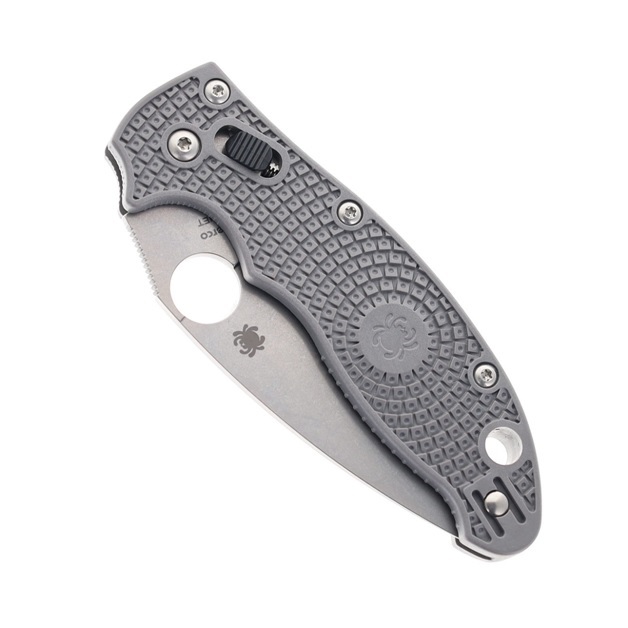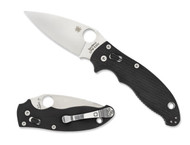The Manix 2: A Great Example of a Spyderco Pocket Knife
16th Dec 2024
The Manix 2 is not a Spyderco pocket knife that is commonly lauded as the best. Often, that title goes to models like the Delica, Para 2 or 3, or Tenacious, among a few other frequent fliers.
But the Manix 2 is a beloved Spyderco pocket knife all the same and definitely one of the best, even if popular opinion is discounted.
This post will break down some of the features of this Spyderco knife, specifically the model with G10 scales and a CPM-S30V blade (link above).
Size and General Ergonomics
The Manix 2 is 8” overall, 4.66” closed, with a 3.37” blade with a straight edge. The model with G10 scales weighs 4.9 ounces, so it’s actually a pretty dense knife that carries well, despite the fact that it’s not that big.
Both open and closed, the knife handles well; closed, most of the angles are rounded off. Opened, the scales feature no rough or hard edges and the knife indexes well.
There are two choils, one machined into the scales and one formed by the unsharpened shoulder of the knife when it is opened, granted great control over the knife when in use, and affording the versatility of a number of different grip styles.
All in all, it is a great knife for EDC because it is not that small, but not so big that it will attract unwanted attention; besides, the ergonomics are solid regardless of your intended purpose.
Blade Profile
Like so many other Spyderco knives, the Manix 2 sports a leaf-shaped blade. It has a straight edge and a gently curving belly and spine.
Along the spine of the knife, there is a generous thumb ramp with jimping, although the ramp is not as pronounced as it is in some other models. It’s actually fairly shallow as far as a Spyderco goes.
Regardless, this blade profile is useful for a wide variety of tasks, including but not limited to slicing as well as draw and push cuts. For general utility and EDC applications, it’s a great profile that is not over-specialized, and therefore is not limited by excessive refinement.
Blade Steel
The blade steel is easily one of the strongest selling points of this Spyderco pocket knife. It’s made with CPM-S30V super steel.
Made by Crucible Industries (CPM stands for Crucible Particle Metallurgies), CPM-S30V steel is rich in carbide-forming molybdenum and vanadium, and it has a lot of carbon, too.
Carbon content is 1.45%, whereas vanadium and molybdenum content are 4% and 2%, respectively.
This carbide-forming content of S30V makes it uniquely able to take a razor sharp edge and hold it very well. The high carbon content also enables it to take a very good heat treatment, making it tougher than your average steel.
It’s a bit harder to sharpen than some other softer alloys, but it’s also not impossible by any stretch.
This is also a very tough steel alloy that is resistant to chipping and snapping, even under heavy side-loading. In a knife of this size, you’ll never have an issue unless you positively abuse it.
The other great thing about S30V is its high chromium content, which comes in at 14%, making it highly corrosion resistant - not the best on the market but pretty good as far as premium super steels are concerned.
Blade Grind
Like the majority of other Spyderco pocket knives, the Manix 2 is made with a full flat grind. This situates it ideally for slicing tasks, as it not only yields a very fine edge, but renders the edge easy to restore - at least comparatively, and without respect to steel alloy. The full flat grind, while also being easy to resharpen, is also good for detail work and is less fragile than other grinds such as hollow grounds.
Deployment
As in many other Spyderco pocket knives, deployment is via a naturally-ambidextrous thumb hole, affectionately dubbed a “Spydie-hole” by brand acolytes. It takes a little getting used to especially for users that are more frequently acquainted with flipper tabs and thumb studs, but after you get the hang of it the thumb holes are a snap to use. Also, they can never become loose or pop off like thumb studs, so in that respect you might even say they’re better.
Lock Type

Another really great feature of this Spyderco pocket knife is its use of a completely novel lock type, known as a ball bearing lock.
No, that is not a mistyped reference to the ball bearing mechanism of the pivot - that is what the lock is called.
A ball bearing lock consists of a hardened steel ball bearing housed in a polymer cage; when the blade is opened, the action of a plunger under spring power drives the ball bearing assembly forward into a ramp on the blade, which wedges and locks it open.
To unlock the blade, you simply depress the plunger by pulling it to the rear. It’s sort of like a button lock. Instead of depressing the button you slide the button backwards.
Not only is this lock extremely strong - among the strongest folding knife locks in the industry right now - it is also very easy to use, very reliable, unlikely to unintentionally disengage, and very strong, since it enables a user to open and close the blade one-handed, without putting the fingers in the way of the blade’s path.
One of the other great things about the ball bearing lock is that it is also very fidget-friendly, just like a button lock.
Carry and Other Features
In addition to what’s been mentioned here so far, the Manix 2 comes with a reversible tip-up pocket clip, sports a lanyard hole, and boasts black G10 liners that are not only extremely durable and wear-resistant - they also require no maintenance.
Want to Explore More About This Spyderco Pocket Knife
Thinking this might be the Spyderco pocket knife for you? We carry it, along with other versions of the Manix 2, in addition to plenty of other Spyderco knives. Check them out in our full Spyderco collection and get in touch with us at WhiteMountainKnives@gmail.com if you have any questions before buying.









